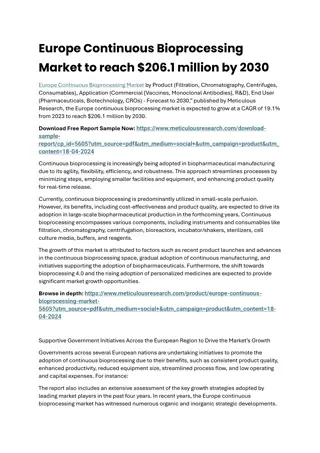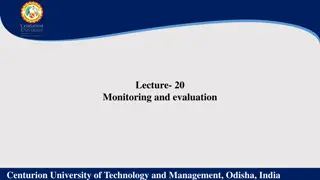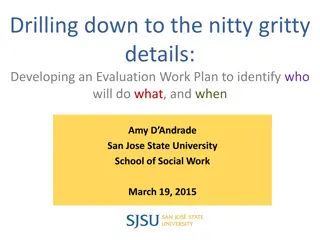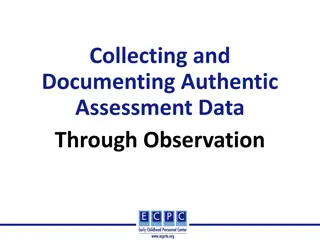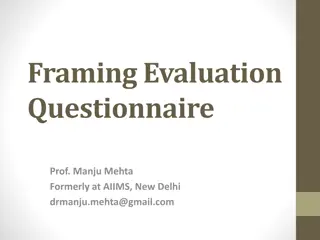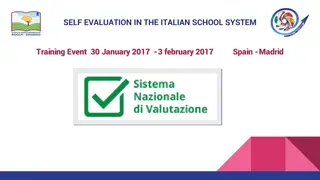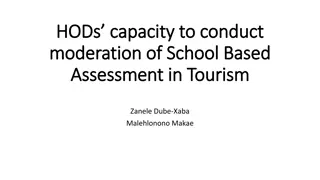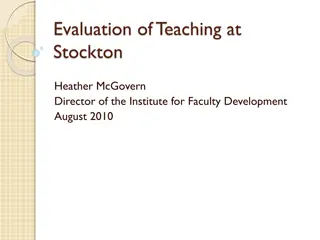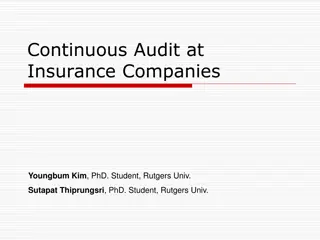Continuous Comprehensive Evaluation System: Features and Assessment Areas
The Continuous Comprehensive Evaluation (CCE) system focuses on assessing students' development through a variety of tools and techniques. It emphasizes continuity in evaluation, covers all aspects of a student's learning, and includes scholastic and co-scholastic assessments. The system comprises formative assessments like class work, homework, oral questions, and quizzes, along with summative assessments. It is structured in two terms per academic year with specific assessment criteria for each subject.
Download Presentation

Please find below an Image/Link to download the presentation.
The content on the website is provided AS IS for your information and personal use only. It may not be sold, licensed, or shared on other websites without obtaining consent from the author.If you encounter any issues during the download, it is possible that the publisher has removed the file from their server.
You are allowed to download the files provided on this website for personal or commercial use, subject to the condition that they are used lawfully. All files are the property of their respective owners.
The content on the website is provided AS IS for your information and personal use only. It may not be sold, licensed, or shared on other websites without obtaining consent from the author.
E N D
Presentation Transcript
Welcome to Orientation Class X 2016-2017
ACADEMIC ASSESSMENT FOR CLASSES IX & X WILL BE BASED ON CCE or CONTINUOUS COMPREHENSIVE EVALUATION
Continuous and Comprehensive evaluation Continuous and Comprehensive evaluation refers to a system of school based assessment refers to a system of school based assessment that covers all aspects of a student s that covers all aspects of a student s development development It emphasizes two fold objectives. It emphasizes two fold objectives. Continuity in evaluation and assessment of broad based Continuity in evaluation and assessment of broad based learning. learning. Behavioural Behavioural outcome. outcome.
FEATURES OF CCE CONTINUOUS CONTINUOUS Continual from the beginning and during the instructional process Periodicity frequency /term
Comprehensive Comprehensive Scholastic - Subject specific areas. Co-Scholastic Life Skills, Work Experience ,Visual and Performing Arts and Attitudes, Values and other Co Curricular activities Includes a variety of tools and techniques for assessment of the learners.
AREAS OF ASSESSMENT Scholastic and Co-Scholastic
Scholastic SUBJECT WISE ASSESSMENT English Math Science Social Science Hindi / Sanskrit / French
CLASS X CLASS X An academic year will have 2 terms - FIRST TERM April to September SECOND TERM October to March
CCE at Secondary level in CBSE schools Each term will have two formative assessments & one summative assessment in each subject. FA (1) 10 FA (2) 10 SA (1) 30 Term I FA (3) 10 FA (4) 10 SA (2) 30 Term 2
FORMATIVE ASSESSMENT (FA) FORMATIVE ASSESSMENT (FA) Will comprise of : Will comprise of : Class work Class work Homework/ Homework/ Educosoft Oral questions Oral questions Quizzes Quizzes Projects Projects Assignments/Tests Assignments/Tests Role Play Role Play Seminar Seminar Group Discussions Group Discussions Presentations Presentations Movie making Movie making Educosoft
SUMMATIVE ASSESSMENT(SA) SUMMATIVE ASSESSMENT(SA) Will be End of Term Examination Will be End of Term Examination Summative Assessment Summative Assessment I in September (TERM I in September (TERM- -I) I) Summative Assessment Summative Assessment II in March (TERM II in March (TERM- -II) II) Curriculum and syllabus as circulated by the Board. Curriculum and syllabus as circulated by the Board. Question papers will be sent by CBSE. Schools also have a Question papers will be sent by CBSE. Schools also have a choice to make their own question papers as per CBSE choice to make their own question papers as per CBSE guidelines. guidelines. Exams will be conducted by schools. Exams will be conducted by schools. Evaluation of Answer scripts will be done within the school Evaluation of Answer scripts will be done within the school. .
Term I - (April 16 Sept. 16) a) Paper-Pen Test : 35 b) Activity based Assessment : 10+5 a) Activity Based Assessment : 10+10 b) Project/ Lab Activity : 15 c) Notebook Assessment: 5 Term II- (Oct. 16 March 17) a) Paper-Pen Test : 35 b) Activity based Assessment : 10+5 a) Activity Based Assessment : 10+10 b) Project/ Lab Activity : 15 c) Notebook Assessment: 5 Formative Assessment I (FA I) Formative Assessment II (FA II) Formative Assessment III (FAIII) Formative Assessment IV (FA IV) Summative I English - ASL 20 marks, Pen & Paper test 70 marks Science, Math, Social Sc, Hindi/Sans/Fr Pen & Paper test 90 marks Summative II English - ASL 20 marks Pen & Paper test 70 marks Science, Math, Social Sc ,Hindi/ Sans/Fr Pen & Paper test 90 marks
ASSESSMENT OF SPEAKING AND LISTENING SKILLS IN ENGLISH LANGUAGE UNDER CCE, CBSE HAS INTRODUCED A NEW KIND OF TEST FROM 2012- 2013 AS PART OF THE ENGLISH LANGUAGE ASSESSMENT CBSE IS TESTING STUDENTS LISTENING AND SPEAKING SKILLS FOR 20 MARKS THE MAIN LANGUAGE PAPER IS OF 70 MARKS THESE TESTS ARE A PART OF SUMMATIVE ASSESSMENTS ( SA1 and SA2) THE BEST SCORES WILL BE REFLECTED IN FINAL RESULT.
Introduction of Value based questions Introduction of Value based questions With effect from the academic session 2012 With effect from the academic session 2012- -13 students are assessed in all major subjects for up to 5 marks at are assessed in all major subjects for up to 5 marks at the Summative Assessment level in Classes IX and X, the Summative Assessment level in Classes IX and X, through questions which will be integrated with the through questions which will be integrated with the content of the subject and analysed on the basis of the content of the subject and analysed on the basis of the values it reflects values it reflects. 13 students
Operational Modalities 1 Operational Modalities 1 Performance will be assessed using conventional Performance will be assessed using conventional numerical marking and these will be converted into numerical marking and these will be converted into grades. grades. Grades will be awarded on a Grades will be awarded on a 9 point scale 9 point scale. . The CBSE will issue a statement of Subject wise The CBSE will issue a statement of Subject wise performance i.e. Grade Sheet (NO MARKS) at the performance i.e. Grade Sheet (NO MARKS) at the end of class X. end of class X.
NINE POINT GRADING SCALE Marks Marks 91 100 Grade Grade A 1 Grade Grade Point 10.0 Point 81- 90 A2 9.0 71-80 B 1 8.0 The qualifying grade The qualifying grade in each subject under in each subject under Scholastic Area A Scholastic Area A shall be minimum shall be minimum Grade D Grade D 61-70 B 2 7.0 51-60 C 1 6.0 41- 50 C 2 5.0 33-40 D 4.0 21-32 E 1 ---- 20 & below E 2 ----
Operational Modalities 2 Operational Modalities 2 The CCE card will apply in all the CBSE The CCE card will apply in all the CBSE schools across the country for admission schools across the country for admission into class XI. into class XI. In addition, schools can have their own In addition, schools can have their own criteria for admission to class XI. criteria for admission to class XI. Students will be promoted on the basis Students will be promoted on the basis of both Formative and Summative of both Formative and Summative assessments, both of which are mandatory. assessments, both of which are mandatory. A minimum of 25% marks of have to be A minimum of 25% marks of have to be scored in SA I & II. (Overall 33%) scored in SA I & II. (Overall 33%)
AREAS OF ASSESSMENT (CONTD)... Co-Scholastic Areas PART 2 2A( Life Skills) Thinking Skills Social Skills Emotional Skills
Co-Scholastic Areas 2B WORK EDUCATION The indicators of assessments are as follows: Has a collaborative approach towards the process of learning. Is innovative in ideas. Plans and adheres to timelines. Is involved and motivated. Demonstrates a positive attitude. Is helpful, guides and facilitates others. Demonstrates an understanding of correlation with real life situations. Has a step by step approach to solving a problem. Has a clear understanding of outcome to be generated. Is able to apply theoretical knowledge into practical usage.
PART 2 Visual and Performing Arts (Part 2C) Painting and drawing Painting and drawing Dance Dance Music (Indian & Western) Music (Indian & Western) Theatre Theatre
PART 2 2D (Attitudes & Values) Attitude Towards Teachers Attitude Towards Teachers Attitude Towards School Attitude Towards School- -Mates Attitude Towards School Attitude Towards School Programmes Programmes and Environment and Environment Value Syste Value Systems Mates
PART 3 PART 3 3A Literary & Creative Skills Literary & Creative Skills Organisational Organisational and Leadership and Leadership Skills Skills- - TGelf TGelf 3B Sports Sports NSS NSS- - School Enterprise Challenge, School Enterprise Challenge, Working with Working with Muskaan Muskaan & Teaching EWS students EWS students & Teaching
ASSESSMENT OF CO-SCHOLASTIC AREAS WILL BE DONE ON A FIVE POINT SCALE GRADE GRADE GRADE GRADE RANGE RANGE 4.1-5 3.1- 4.0 2.1-3.0 1.1-2.0 0.1-1 GRADE GRADE POINT POINT 5 4 3 2 1 A B C D E
Evaluating Co Evaluating Co- - Scholastic Areas Scholastic Areas Anecdotal Records Anecdotal Records An anecdotal record is the observed behaviour of a student. It is a record of some significant episode that happened in the life of the student and which sheds light on the conduct, thinking, skills and capabilities, revealing significant features and characteristics about his/her personality. Date : 20 / 3/ 14 Manik Sharma He picked up the newspaper lying on the floor and stacked it with other papers on the cup- board.
Portfolio It is the collection of evidence of a student s work over a period of time. It could be day-to-day work or selection of the learner s best piece of work.
PORTFOLIO CAN INCLUDE THE FOLLOWING Photographs Certificates of Merit/ Achievements Paintings and other examples of artistic endeavour Audio-Video Recordings (CD) Self Assessment Sheets Peer Assessment Sheets Teacher Assessment Sheets Any kind of Literary work Interests and hobbies Write up on social work done by the student
Based on grades obtained by a student in Co-Scholastic areas he/she can be up scaled in one or two subjects. a) Those Students who get total grade points in co- scholastic areas/ activities in the range 53 benefit by getting upgraded to the next higher benefit by getting upgraded to the next higher grade in two subjects in scholastic areas. grade in two subjects in scholastic areas. 53- -65 may 65 may b) Those students who get total grade points in the range 40 40- -52, may benefit by getting upgraded to the 52, may benefit by getting upgraded to the next higher grade in one subject in scholastic area. next higher grade in one subject in scholastic area. c) Up scaling will be done from lowest grade to next c) Up scaling will be done from lowest grade to next higher grade and so on. higher grade and so on. d) E2 grade will not be up scaled. d) E2 grade will not be up scaled.
Each area in Life Skills has ten indicators which are valued out of 5 marks and the total scored is then divided by ten to attain the grade point For Example If a child scores 35 marks in thinking skill, his/her grade will be B and Grade point will be 3.5 Similarly all other areas are assessed in marks and then converted into grade and grade point. The maximum grade point a student can attain is 65.
There Secondary(Class X) level w.e.f. 2011 for students studying in the schools affiliated to the Central Board of Secondary and who do not wish to move out of the CBSE system after Class X. is no Board Examination at the
IMPORTANT WEB SITES FOR REFERENCE www.cbse.nic.in www.cbseacademic.in




